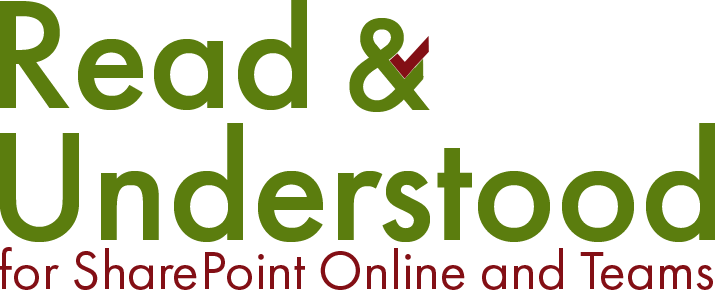Having worked with SharePoint since 2003 we have seen organisations implement the document management features of SharePoint in many ways. Some organisations just opt for version control, others go much further by implementing records management and other SharePoint features. In many cases the use of document libraries is prolific with the focus being on the association of content based on the perspective of its origins (often departmental). This is where most organisations stop, with the implementation viewed as a job done because all the documents are now in SharePoint and covered by one or more of SharePoint’s document management features.
But no matter how well controlled documents are in respect to their publication, review and editorial cycle; it's very often that the end user, the consumer of the content, that is left to find publications that are new or updated on their own devices.
SharePoint does offer solutions to this with Alerts, custom Workflows or Microsoft Power Automation - Flow. These are either too granular to configure and administer on a large scale to cover all users or require skills that most end users just don’t have. Therefore, after working with SharePoint for over 17 years, we decided to develop Read and Understood for SharePoint.
Read and Understood implements processes that keep users informed of new and updated policies, procedures and any other key documents without the complexity of custom workflow or arduous administrative overhead to manage Alerts on a company wide scale.
Q. In your opinion what are the main challenges faced by organisations needing to publish Polices and other key documents?
To save repetition the term key documents will be used in the remainder of this post to refer to Policies, Procedures and key company documents.
1. Ensuring the right employees read the key documents
As soon as a key document is approved and published its good practice to ensure that relevant employees have a chance to read it. Using SharePoint to control and publish is a great start but you still have no idea who’s read the document. Sending paper copies used to be a solution, getting users to sign the document, in years gone by but they typically just piled up on desks due to time constraints. Read and Understood was created so organisations maintain complete control over key documents by having controls to target specific groups (SharePoint or Azure Active Directory) of users with email-based notifications. Notification is the Read and Understood equivalent of a SharePoint Alert, with some significant enhancements. Management of Notifications is configured through a Settings List to simplify administration. Configuring a notification is as simple as writing an email; use relevant groups or individual employees to receive the email. Our quick start templates for the notification emails will provide the user with the information, provided in the template, including a link to the document.
Read and Understood provides two levels of Notification:
Notification - an email with details of the key document that’s been added or updated.
Acknowledge reading – the user is required, using a link in the email, to confirm they have Read and Understood the document. Through the Settings List you can define rules that sets how long users will have to acknowledge the document, during that time if they have not acknowledged then reminders can be sent. Read and Understood keeps a full audit trail of each document and its version cycle detailing who did or did not acknowledge within the allocated time. A report email is sent to key document owners summaries the information at the end of the cycle.
2. Smart user management for new starters and internal movements
All Read and Understood features can use a combinations of Azure Active Directory (AAD) user accounts or groups and/or SharePoint groups to notify users.
When Read and Understood enters its notification cycle, triggered by a new or updated document, it will ensure any new members of the groups are included in the notifications.
3. How much effort does it take to get Read and Understood add-in up and running?
With over 30 years’ experience in implementing 3rd party solutions we're acutely aware that the setup for any solution can be arduous and time-consuming. Read and Understood administration has been designed to ensure that implementation effort is kept to a minimum but of course this does depend on how your content is structured in SharePoint.
Read and Understood is administered through the creation of items in a Read and Understood Settings List working with one or more (no limit) document libraries in a site collection.
Read and Understood is an add-in that that is added to the SharePoint App Catalog. Once added and deployed, sites can be added to the sites you wish to enable it.
To enable Read and Understood notifications involves the following steps to be taken:
Identify all the document libraries that contain your key documents
Add the Read and Understood for SharePoint Add-in
Enable Read and Understood on the libraries identified in step 1
Define the type of notification you want to send, who should receive it by assigning the appropriate groups or users. If you want to, tailor the email message using the rich text editor to style it or get the message you want across.
That’s the end of this post and I hope you’ve found it informative and thought provoking.


